This is a multi-part series. See the others here: Part 1 and Part 2.
Copenhagen
In Part 2, I shared the comical travails of getting from Berlin to Copenhagen. After a stopover in Hamburg, the story continues.
On my last train of the day, I met a German woman named named Christina who lives in Norway. She was a hospital worker, and was returning home and cutting short a holiday to Germany because of the coronavirus. The train ride was also interesting because at one point it crosses over the 10-mile wide Great Belt, a strait that separates the western half of Denmark from the island of Zealand, the country’s most populous region and the home of Copenhagen. Trains cross half the Great Belt on a bridge, and the other half in a tunnel. Prior to this link’s completion in 1998, only ferries crossed this area. Passenger trains would be loaded onto those ferries back in the day.
Copenhagen itself is a delight. The first thing I noticed when stepping outside the station was some kind of amusement park across the street. Perhaps more so than other cities, I found there is a very large pedestrian zone and central shopping district. Commercial and utility vehicles are allowed, and private cars can go on some other peripheral streets. The buildings are all obviously old but tenderly maintained. My hostel roommates weren’t talkative at this stop, but the downstairs bar had a lively social and music scene despite (or because of?) the dreary weather.
The morning of March 11, I took a jog and found a very wide, un-Amsterdam-like canal, but it was calm enough to be swan habitat. I later learned this waterbody is actually part of several urban lakes which were dammed hundreds of year ago for defense and water supply. I visited a small breakfast kiosk recommended by a colleague and enjoyed one of the best hot chocolates I’ve ever had.
Next, I took another bike tour. The tour guide was Dutch and he loved that I chose an orange bike, it being the color of the national soccer team. Two other people from California were on the tour, and they had just visited Seattle and Vancouver. They also, tellingly, chose to ride Segways instead of bikes. We saw the royal palace, the famous mermaid statue, parliament, and other major sites. I also couldn’t help myself from snapping a picture of a DHL delivery cyclist.
Afterwards I took a trek to the industrial area to see Copenhill, an artificial ski run built on the roof of a waste incinerator facility. Not realizing there was an elevator, I hiked the 85 meters up past acres of artificial grass. The view view was stunning – you can see all the way into Sweden, including the huge Øresund Bridge – and it was dramatically windy. Next door an honest-to-goodness wrecking ball was taking down a concrete building. I stuck around a while, hoping to witness a skier climbing the series of tow bars, but I didn’t have any luck. I walked down and saw the skiers drinking at the bar, of course (this was still mid-morning).
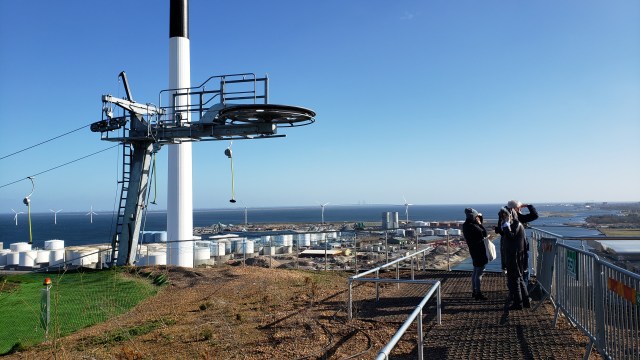
The view from Copenhill looking over a major industrial area, wind turbines, and the Baltic Sea.
After that I took buses and trains to a residential area to see Gridvick Church, a masterpiece of Danish masonry. From afar the building looks pretty unassuming, but up close its quite a splendid presentation of massive forms made from modest materials. From there I headed back into the old center city and visited the medieval Rundetaarn (Round Tower), which has a steep spiral ramp up to the top. Climbers are awarded a great skyline view from within the city.
As I headed back the hostel during the evening commute hour, I was stunned and nearly mobbed by the rivers of cyclists. As I had experienced in the morning, even on a chilly day Copenhagen is clearly a great city to bike in. You can also find all kinds of food – near my hostel I opted for a comfort option serving enchiladas one night, and other night I had the local fish and chips.
The next morning on March 12, I woke up to information about the United States restricting Europeans from entering the country. I had a flew of worried emails from family. I quickly read the news and State Department websites myself to find that the restrictions did not apply to US citizens or nor to flights arriving from Britain. Since I wasn’t affected, I decided to go onward with my flight that morning to Oslo. Fortunately, I had chosen a relatively late flight leaving at noon, so I had plenty of time to relax and commute in the morning. I found a cafe with excellent hot chocolate and a maple croissant, and later took a subway train to the city’s beautiful airport.
Oslo
I could have technically taken a train from Copenhagan, but I decided that any trip that took eight or more hours by train was best to fly instead. My March 12 flight to Oslo was uneventful except for heavy wind on takeoff. Upon landing and looking out the plane window, I saw patches of snow, fir trees, and low-lying mountains that gave me a vague reminder of the American west, maybe Colorado or Idaho. I was definitely bound for a colder leg of the trip as I advanced towards the north pole.
Getting from the airport to central Oslo was a bit more challenging than I expected. I later learned the airport is over 50 kilometers (31 miles) from the city center by train, and choosing its location was a local controversy in the 1980s. At the time I was traveling there was not a direct line and I had to transfer, with the first train ticket costing $20 and the next one costing $11. Of course, I can imagine a taxi ride would have been twice as much.
Emerging from the south side of Oslo Central Station, I could immediately see the city has a stunning waterfront and busy harbor. There are a large number of sleek, low-rise modern buildings including the massive Operahuset. The main part of town where I was staying, though, had a surprisingly regular street grid with a mix of historical and contemporary 4-6 story buildings. In fact, during the rest of my time in Oslo I was constantly impressed with how wide the sidewalks were and the long sightlines (straight streets) to help me get oriented – something that wasn’t easy to find in the cramped medieval centers of other cities on my trip.
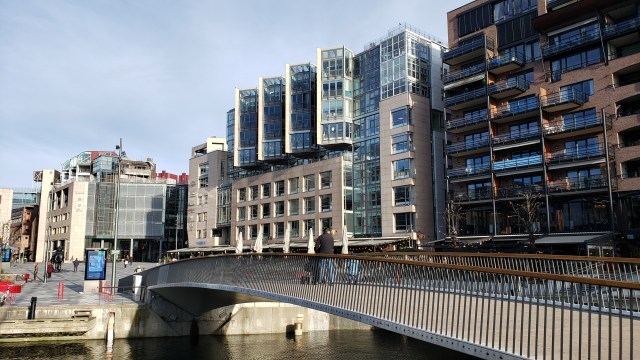
Part of the Oslo waterfront district.
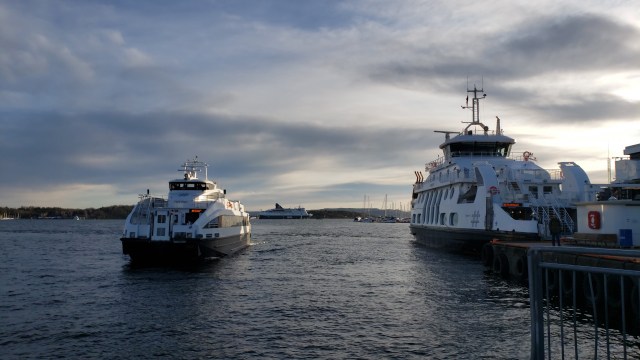
A number of passenger ferries serve Oslo.
I suited up for a cold, windy jog to check out the shoreline. The number of ferries plying the harbor reminded me of Seattle, and in the distance I even saw a cruise ship juxtaposed with a grain elevator, but the resemblance stopped there. The downtown waterfront, particularly the Tjuvholmen and Aker Brygge districts, is developed intensely with high-quality residential and commercial buildings, a grand harborside promenade, and a small grid of pedestrian shopping streets. Among it all restaurant seating spills outside.
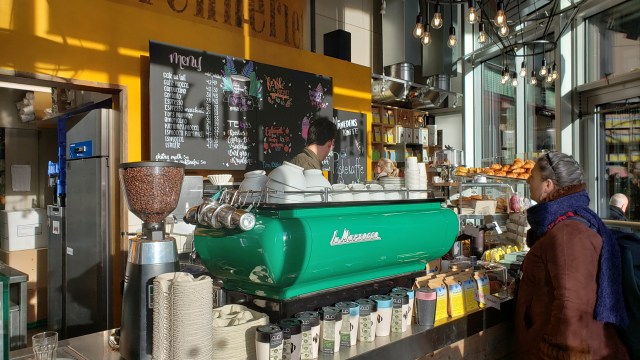
Grabbing a coffee at Kaffebrenneriet.
I found a wayfinding sign showing the Havnepromenaden trail extends 9 kilometers, which was further than I had time to explore, but it seemed like a great civic amenity from my brief visit. I also came across piles of pavers and construction equipment for a street project that was converting two major diagonal streets into a pedestrian zone, which apparently opened in February 2021. I didn’t notice at the time, but the site was using electric construction vehicles. On my way back to the hostel, I also found a transit-only street filled with buses and streetcars.
At my usual postcard gathering, I saw some paintings that reminded me Norway (and other Scandinavian cultures) its steeped in troll mythology. Netflix users might know the “documentary” Troll Hunter, which follows a group of college students trying to prove the government is covering up the existence of real trolls. It’s a delight, and makes we wish I had time to visit the countrywide on this trip. I definitely want to visit the famous fjords someday, which are a couple hundred miles northwest of Oslo.
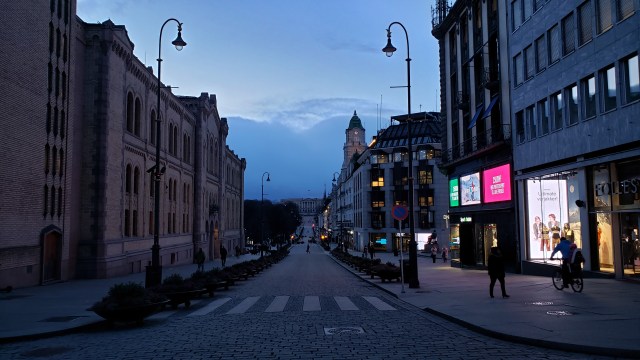
A quiet street scene in Oslo.
I nearly seriously injured myself after dinner that night. I was tired of carbohydrates (despite passing by a bright restaurant called Texburger) and found a place offering eccentric salads with a variety of grains and vegetables. Leaving the cafe, I didn’t notice the single step down to the sidewalk, and I rotated my ankle. I was instantly worried about the implications of seeking medical care in a foreign country, not remembering how my insurance would handle a hospital visit. But after resting and some tentative steps, I found the joint could still bear weight and didn’t hurt much. Still, I decided to find a pharmacy to get some provisions.
In another forewarning, there was a long line outside the pharmacy and a security guard letting in a limited number of people at a time. This was the first such restriction I had seen on my trip. I was happy to find some instant cold packs to treat my ankle.
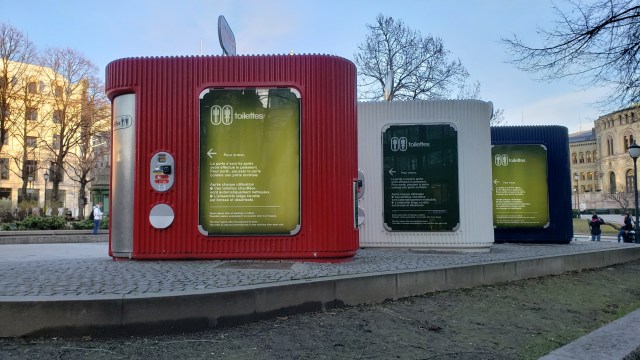
Stylish public restroooms in central Oslo.
I work up early the next day to return to the same train station for a 5:56am departure to Stockholm. This was my longest train ride of the trip, at 6.5 hours, and it was quite relaxing to take my mind off the itinerary for a while. My window scrolled through a long landscape of farms and forests under an overcast sky, reminding me a bit of the sparse Russian wilderness I have only seen in movies (which must have been in roughly the same latitude). Helpfully, the train conductor announced when we crossed the border.
Stockholm
On my walk from the train station to my hostel, I noticed that compared to Oslo this city has wider streets and more car traffic (including a lot of Volvos), but that didn’t make it any less pleasant to walk in. There is plenty of the necessary infrastructure for people walking and cycling, and the ground floors of buildings are stuffed with shops and cafes and carved with all variety of architectural nuance. I also got a view of this priority when passing underneath some kind of viaduct near the train station; it seemed the conversation had gone, “We need to have an elevated street here? Fine, let McDonald’s open up shop beneath it then.” As terrible as elevated highways in American cities are, maybe they could be a little better with this kind of creative thinking.
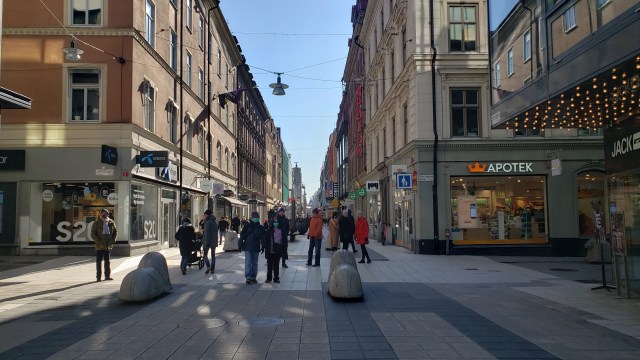
The long Drottninggatan pedestrian street in Stockholm.
After dinner that night, I took a long stroll down Drottninggatan, possibly the longest pedestrian street I had encountered so far. It was at this time I started thinking I would probably need to seriously revise my trip because of the pandemic situation. My family who planned to join later in the trip were showing signs of backing out. Back at the hostel that night I learned that the Czech Republic, my next destination, was locking down and its national train company notified me of the cancellation of my Prague-Vienna ticket.
So, I cancelled my flight to Prague and booked a flight directly from Stockholm to Vienna.
Two hours later I got an alert from the U.S. Embassy in Vienna advising against travel in general, and later I found news Austria was going to require a medical certificate from anyone who had traveled to France in the past two weeks. I also got an email from the U.S. Embassies in Bern and Madrid that Switzerland and Spain were introducing some border controls. Denmark closed its borders to tourists two days after I left. Later I would learn the Switzerland ski resort I planned to visit for three days was closing down. I was also reading about restaurant and museum closures that would degrade the tourism experience.
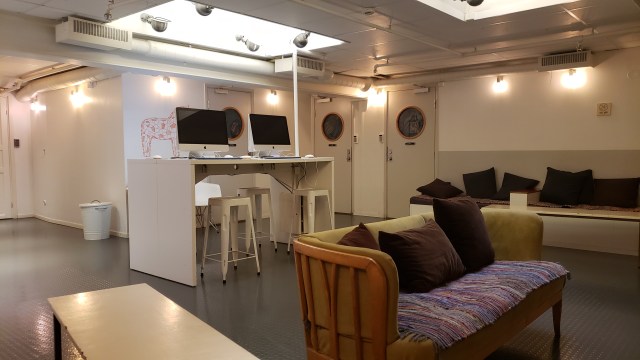
While the ending of my trip was saddening, I at least had a cozy space to work in at the hostel.
I felt confused and devastated as my plans began to fall apart. I stayed up late thinking things through. It didn’t seem fair. There’s no way I could have predicted that a once-in-a-century pandemic would coincide with my dream trip that I had saved and planned for five years. But that seemed to be what was happening in real time.
I had another private room at this point in the trip – which I was thankful for as I considered all the logistics of cancelling my trip and working through the emotions. While the miniature washer and dryer at this hostel left something to be desired, the comfy basement computer room was a blessing. It’s much easier to do urgent travel research and re-bookings on a big computer screen than a little smartphone.
After sleeping on it, in the morning I finally determined it wasn’t worth my time and effort to attempt wiggling through an ever-tightening maze of restrictions and cancellations. I sadly booked a British Airlines flight back to the United States, from Stockholm to London to Chicago. The flight wasn’t for two days later; that timing was decided because of a lower price, a chance to fly on a Boeing 747, and a desire to spend one extra day in Europe while I could. Or, perhaps I was a victim of Stockholm syndrome.
My mood didn’t stop me from going out and enjoying the city, which was providing blissfully blue skies. I found a place that offered a British-style breakfast with eggs and beans, plus a healthy side of bacon. The weather was chilly and sunny as I set out to explore and pick up my last set of postcards. I remembered that Stockholm is situated on several islands, and this was apparent from how often I would encounter water during the day. I stumbled onto Stockholm City Hall, a centuries-old brick building with a large waterside lawn. Here I recorded a video narrating my decision to end the trip early.
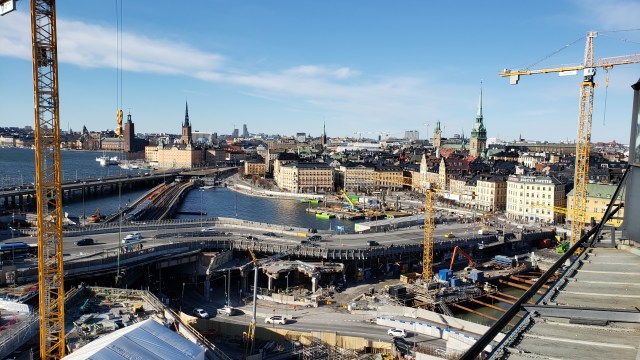
The Slussen renewal project.
I wandered southward across a major bridge that also seemed to be part of a major infrastructure construction project. It was hard to tell exactly what I was looking at in the waterway between islands, but I recognized a coffer dam and some kind of prefabricated roadway structure positioned nearby on a barge. Nearby on a closed street, what looked like a train tunnel was being dug through a bluff. I found a staircase built into the bluff and found a handy overlook over the project site, crowded with other visitors. It turns out the transport bridges here actually sit on top of an aging lock between a lake and the sea called the Slussen, and all of the pieces here are being redone in a public works project intended to add new space for buildings and parks.
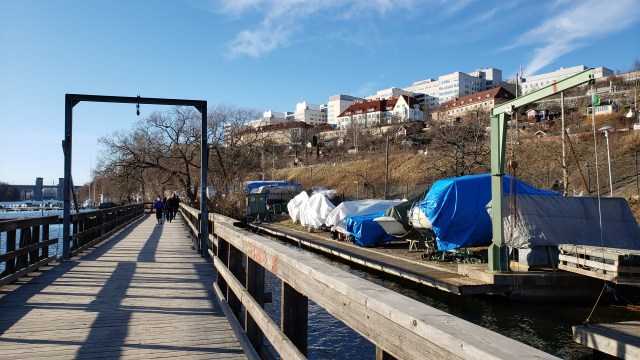
Eriksdalslunden park.
Eventually I came across a large plaza called Medborgarplatsen, or Citizen Square, packed with people and cafe seating. I grabbed a snack and then wandered off the beaten path, downhill into a large park in a dense residential area on the south end of this island. The park, called Eriksdalslunden, included a large community boatyard and a community gardens (people must “put their name on the waiting list and hope for the best”, a sign advises).
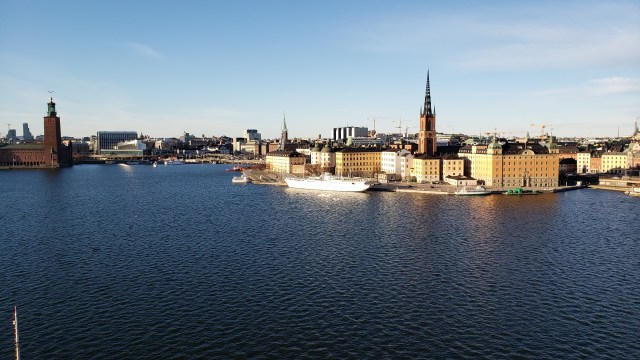
The Stockholm skyline.
Later on in the day my phone battery started to die, so I don’t have a lot of photographic memory to rely on. I do remember making my way back to the north end of Södermalm island and discovering a kind of urban hiking trail, a wild-looking dirt route perched on a cliff overlooking the city center. I enjoyed the sunset view with locals, including one who launched a drone.
Some pedestrian quirks I also noticed: Many of the sidewalks and stairs near hillsides had pre-positioned boxes of sand, apparently available for public use during the icy winter months. And instead of piling cardboard on sidewalks or in dumpsters, it looked like many businesses and apartment buildings collect recycling in huge, sturdy bags that can be picked up by trucks. Throughout Stockholm the streets were spotless and safe to walk on, so they’re doing something right with pedestrian mobility.
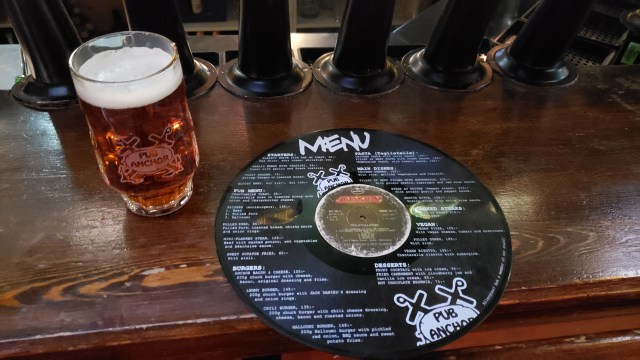
The menu at Pub Anchor.
Back on the main island, I took a beer stop at a local cafe, and later that night found myself in a music bar that played right into the Swedish metal culture; the menu was printed on an old vinyl record and whiskey was piled atop some Marshall amplifiers behind the bar. I’m told that metal music is so popular in Sweden because people there otherwise leave very peaceful and idyllic lives, so who can blame for wanting to let off some steam and rage? And in another staple of Sweden, the next day I would stumble into a small Ikea showroom.
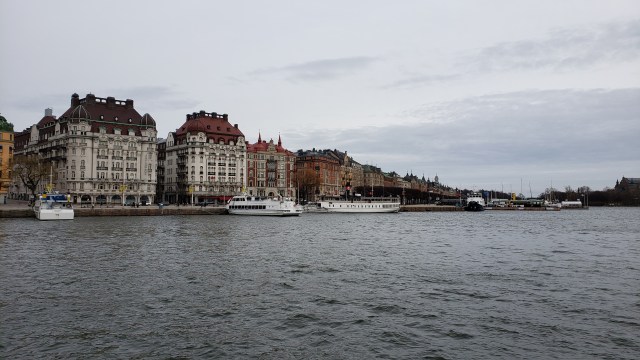
One of the many waterways at Stockholm.
My last full day, March 15, was very windy. Braving the chill, I took a morning jog and explored more of the residential area around my hostel. I also walked through a subway station out of curiosity, noticing that the concourse had a number of retail shops built into it (again, a common feature throughout Europe). A small grocery store was nearly out of toilet paper, a funny parallel from news back home. And at one of the city’s many ferry landings in a small harbor, I found another reminder of Seattle: A piled of crusty shared bikes and scooters pulled out of the water. I also walked through a flea market, with offerings ranging from menorahs to Super Nintendos. That night, I dined at a small cozy place and ate a fancy version of bangers and mash, reminding me of one of my first meals in London two weeks earlier in the trip.
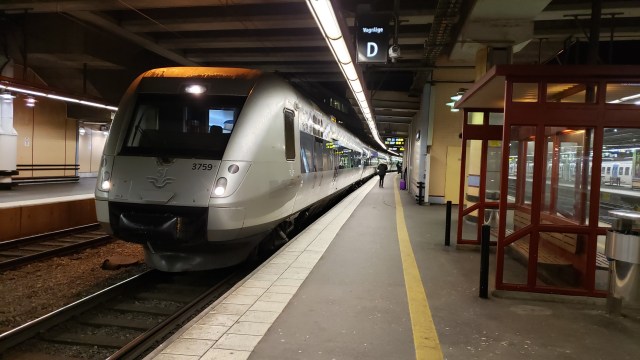
Final train of the trip, heading to Stockholm’s airport.
By 3:30 the next morning, I was on a train platform headed for the airport. It turned out being three hours early for this flight was excessive, the airport being nearly empty when I arrived. Compared to Oslo, price and navigation to the Stockholm airport were a breeze. And while I was sleepy, I could appreciate that the airport station was stunning, underground and showing off bare bedrock all around.
Stepping onto the plane, I bid farewell to Europe and hoped to be back again another day.
Epilogue
I had a long layover at London’s Heathrow, giving me some time to explore it this time around. The passengers on my flight then boarded the plane via buses that took us out to the tarmac, which was the first time I had experienced that process. I was excited to finally fly a 747, the queen of the skies, though of course with my budget I sat in the second to last row of the plane without much of a view. I chatted with some of my fellow passengers, which included Americans who were leaving Europe because of the coronavirus concern. Looking back, I remember this was still a time before we started wearing masks on planes, trains, or anywhere else.
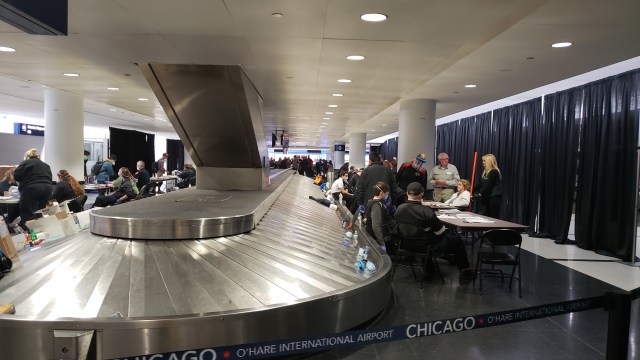
A makeshift screening center set up at Chicago O’Hare.
I landed at Chicago’s O’Hare airport nine hours later, and went through a screening process with staff from the Centers for Disease Control and the Chicago Fire Department. My body temperature was read and I filled out a health declaration confirming I had no virus symptoms.
In hindsight, I should have caught the flight from London directly to Seattle. But I did eventually make it back home via one final leg on American Airlines (and of course, to top it off, I booked what was described as a window seat that had no window).
Arriving back in Seattle, a strange mood had certainly settled in over the city. I was overjoyed to see my partner again, but there was some awkwardness over keeping distance due to my potential for infection. During my absence, what was being called a lockdown had been ordered and my employer had ordered all staff to work from home. It would be several days before I was able to get a computer and re-insert myself into a daily routine.
Parting Thoughts
Even if the trip was cut short, I had a wonderful time in Europe and found it to be a fascinating place. The cities and landscapes are beautiful and can be endlessly explored. As readers will have noticed throughout, I was also fascinated by the continent’s approach to urbanism: compact, walkable, vibrant, transit-rich, and people-first. It’s interesting that Americans love to visit these cities and towns and spend money there, and then return home to suburbia to complain when parking spots are removed for bike lanes or when apartments are proposed in their neighborhood.
As COVID-19 finally seems to ebb and with safe practices now established, I anticipate attempting the same wild itinerary in March 2023. On the next round I may substitute some destinations (e.g. Utrecht instead of Amsterdam; Finland instead of Sweden), but still have the same goals of skiing, riding as many trains as possible, and eating my way through the Mediterranean.
With that, thank you coming on this journey with me, and I wish you safe travels wherever they may take you.
Scott Bonjukian
P.S. I have dropped some tips and tricks throughout this series. To summarize for future travelers, here they are collected:
- Book hostels and train tickets on a single service like hostelworld.com and omio.com. These websites are very easy to use and provide consistent information. It is also helpful to deal with only a single provider in the case of travel changes or refunds.
- Take trains everywhere – both for the intercity trips where you might otherwise fly, and for the local trips. They’re fast, show up frequently, and are surprisingly affordable.
- When booking hostels with shared rooms across a long trip, give yourself a private room every few days. This may mostly apply to solo-traveling introverts. It’s a great stress reliever to relax, refresh, and spread out in your own space.
- Hostels vary in amenities. I found it helpful to book hostels with laundry facilities and complementary breakfast every few days.
- The U.S. State Department guidance and map for country-specific advisories is helpful, if conservative. You can also sign up for country-specific embassy email news.
- Research your international cell phone service options well in advance. I was not entirely satisfied with a France-based company called Orange, where I purchased a European phone number and SIM card and later had unexpected charges. I might have been able to get away with only using a Google Voice number for calling and texting. A key need is access to maps, transit, and restaurant information when you’re out of wi-fi range.
- I got along fine being an English-only speaker, as nearly everyone I encountered speaks it fluently and most signs have it. The most trouble I had was in France, where restaurant servers seemed uninterested in speaking it. Spend enough time in Europe, and you’ll also start to recognize similarities between various written languages on menus and maps that help aid your journey. Nonetheless, I kept a little translation book handy and tried out local phrases when it felt appropriate (especially outside the main tourist areas).
- Bring lots of cash. It’s surprisingly handy for transit tickets, small souvenirs, paid restrooms, and restaurants that may operate cash-only. Tipping is not the norm.
- Bringing a paper copy of every reservation and ticket may have been overkill, but it did give me peace of mind. It is recommended to bring a printout of critical information like a copy of your passport, itinerary, and emergency phone numbers (including U.S. embassies). Put printouts in a plastic sleeve. I also brought backups of everything digitally (PDF files) on my smartphone and on a flash drive.
- If you’re backpacking like I did, carefully plan your clothing choices. I selected some outdoor/adventure style socks, underwear, and shirts that in theory didn’t need to be washed every day, but I did laundry as frequently as I could. Extra socks are essential during the winter/rainy season. I wish I had brought at least one nice button-up shirt for dining out.
- Shoes take up a lot of space for backpackers – I ended up only bringing one pair, my running shoes, which also work great all of the walking you’ll do. It was also helpful to go for a run every day to keep up my exercise and cover more ground in scouting my surroundings.
- For backpackers, stash your big pack in a locker at the hostel during the day (good ones should have those; bring your own lock) and use a small stuffable pack with your essentials for bopping around town. Taking a load off enabled me to explore farther. The small pack is also what I kept at my seat during plane and train trips.
Cheers!




Pingback: An Urban Eurotrip: Part 2 | The Northwest Urbanist
Pingback: An Urban Eurotrip: Part 1 | The Northwest Urbanist
Hey! I finally got to read all of part 3…excellent write up,Scott!
Maybe we can get this set up again some day!
dad